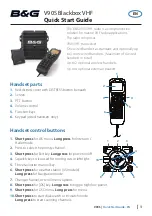
Lemon Microbrick Reference Guide
Page 13 of 20
Elevator (Pitch) axis
Hold the button for
just over 3 seconds
. The second LED (
“
E
”
) will flash. Release the button and the other two
will start flashing for 5 seconds. During that time the elevator response can be reversed by pressing the button.
The direction will be indicated by the
“E”
LED. ON= reversed.
Rudder (Yaw) axis
Hold the button for
just over 5 seconds
. The third LED (
“
R
”
) will flash. Release the button and the other two will
start flashing for 5 seconds. During that time, the rudder response can be reversed by pressing the button. The
direction will be indicated by the
“R”
LED. ON= reversed.
When done, just release the button and wait for normal operation to restore
–
the Microbrick will permanently
store the settings.
Selecting a Receiver Mix
There are four unique mixer modes that can be selected plus one additional dual aileron function.
To select one of the four unique mixes, hold the button for
just over 10 seconds
and all three blue LEDS will flash
simultaneously. Immediately release the button and one or two of the LEDs will be solid blue, indicating current
Mixer mode (see table below). To change the Mixer mode, within 5 seconds push the button briefly. Repeat as
necessary to step to the desired mix. When 5 seconds have elapsed with no button push the latest value is
stored and the receiver is ready to go. Mixer mode settings remain permanent until they are deliberately
changed.
LED
A E
R Mixer function
◉
None: Normal wing and tail
◉
V-Tail. Surfaces connect to onboard servos operated by (channels 3 and 4)
◉
Elevon/Delta. Surfaces connect to onboard servos (channels 2 and 3)
◉
◉
Channels 2 and 4 are swapped. Aileron stick operates rudder.
Explanation of Receiver Mixes
V-Tail
This arrangement is used to control both
pitch
(elevator) and
yaw
(rudder). The tail control surfaces move up or
down together for pitch and in opposite directions for yaw.
In the transmitter,
Aircraft
type
is set to Normal wing. In the receiver, the blue
“E”
LED is ON during setup, thus
indicating on-board V-Tail mixing. The two onboard servos are connected to the two tail control surfaces and are
operated by channels 3 (Pitch function) and 4 (Yaw function).
An aileron servo can be plugged into the outer JST connector and can be operated by channel 2 for Roll. If the
Aircraft type is set to Dual Ail or Flaperon in the transmitter, the second white JST connector will operate a
second aileron servo (channel 6).
Elevon / Delta Wing
This arrangement is generally used for a tailless aircraft, such as a flying wing or delta, in which the wing control
surfaces (elevons) are used to control both
pitch
(elevator) and
roll
(aileron). The elevons move up or down
together for pitch and in opposite directions for roll.
In the transmitter
Aircraft
type
is set to Normal wing. In the receiver, the blue
“R”
LED is ON during setup, thus
indicating on-board elevon mixing. The two onboard servos are connected to the two Elevons and are operated
by channels 2 (Roll function) and 3 (Pitch function).






































